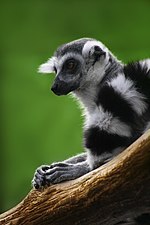Portal:Primates/Selected article/4
Lemurs are strepsirrhine primates, all species of which are endemic to Madagascar. They include the smallest primate in the world, Madame Berthe's mouse lemur, which weighs 30 grams (1.1 oz), and range up to the size of the indri, which can weigh as much as 9.5 kilograms (21 lb). However, recently extinct species grew much larger. As of 2008, 5 families, 15 genera, and 99 species and subspecies of lemur are formally recognized. Of the 99 species and subspecies, the International Union for Conservation of Nature (IUCN) has classified 8 as Critically Endangered, 18 as Endangered, 14 as Vulnerable, 5 as Near Threatened, 8 as Least Concern, 43 as Data Deficient, and 3 have yet to be evaluated. From 2000 through 2008, 39 new species were described and 9 other taxa resurrected.
The number of lemur species is likely to continue growing in the coming years, as field studies, cytogenetic and molecular genetic research continues. There is not complete agreement over the latest revisions to lemur taxonomy, and the debates are likely to continue. In many cases, classifications will ultimately depend upon which species concept is used. In the case of the lemurs of Madagascar, which have suffered extensively from deforestation and habitat fragmentation, nearly 25% of all species are either Endangered or Critically Endangered, most have yet to be extensively studied, and nearly all populations are in decline. For these reasons, taxonomists and conservationists favor splitting them into separate species to develop an effective strategy for the conservation of the full range of lemur diversity. Implicitly, this means that full species status will help grant genetically distinct populations added environmental protection.

